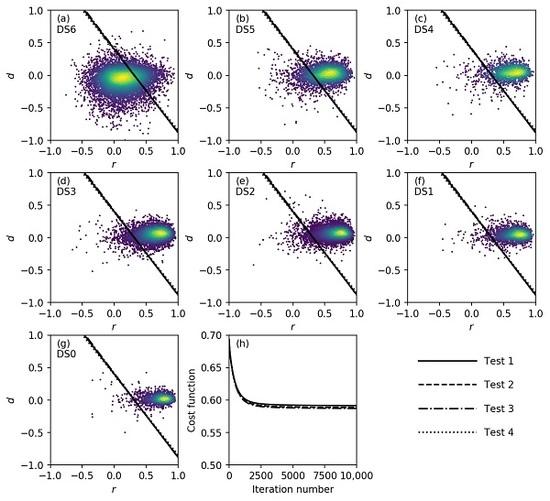Novel Unsupervised Classification of Collapsed Buildings Using Satellite Imagery, Hazard Scenarios and Fragility Functions
Abstract
:1. Introduction
2. The IHF Classification Method
2.1. Fundamentals
2.2. Discussion of the IHF Method
3. Application of the IHF Method to the 2011 Great East Japan Earthquake and Tsunami
3.1. A Problem of Bi-Dimensional Dataset Features Using a Linear Threshold
3.2. Generalization of the Discriminant Function
3.3. Discussion of the Case Study
4. Conclusions and Prospects
Acknowledgments
Author Contributions
Conflicts of Interest
References
- Maruyama, Y.; Yamazaki, F.; Matsuzaki, S.; Miura, H.; Estrada, M. Evaluation of Building Damage and Tsunami Inundation Based on Satellite Images and GIS Data Following the 2010 Chile Earthquake. Earthq. Spectra 2012, 28, S165–S178. [Google Scholar] [CrossRef]
- Liu, W.; Yamazaki, F.; Gokon, H.; Koshimura, S. Extraction of Tsunami-Flooded Areas and Damaged Buildings in the 2011 Tohoku-Oki Earthquake from TerraSAR-X Intensity Images. Earthq. Spectra 2013, 29, S183–S200. [Google Scholar] [CrossRef]
- Hashemi-Parast, S.O.; Yamazaki, F.; Liu, W. Monitoring and evaluation of the urban reconstruction process in Bam, Iran, after the 2003 M w 6.6 earthquake. Nat. Hazards 2017, 85, 197–213. [Google Scholar] [CrossRef]
- Nakmuenwai, P.; Yamazaki, F.; Liu, W. Automated Extraction of Inundated Areas from Multi-Temporal Dual-Polarization RADARSAT-2 Images of the 2011 Central Thailand Flood. Remote Sens. 2017, 9, 78. [Google Scholar] [CrossRef]
- Moya, L.; Yamazaki, F.; Liu, W.; Yamada, M. Detection of collapsed buildings due to the 2016 Kumamoto, Japan, earthquake from Lidar data. Nat. Hazards Earth Syst. Sci. Discuss. 2017, 2017, 1–20. [Google Scholar] [CrossRef]
- Dong, L.; Shan, J. A comprehensive review of earthquake-induced building damage detection with remote sensing techniques. ISPRS J. Photogramm. Remote Sens. 2013, 84, 85–99. [Google Scholar] [CrossRef]
- Balz, T.; Liao, M. Building-damage detection using post-seismic high-resolution SAR satellite data. Int. J. Remote Sens. 2010, 31, 3369–3391. [Google Scholar] [CrossRef]
- Chen, Q.; Li, L.; Jiang, P.; Liu, X. Building collapse extraction using modified freeman decomposition from post-disaster polarimetric SAR image. In Proceedings of the 2016 IEEE International Geoscience and Remote Sensing Symposium (IGARSS), Beijing, China, 10–15 July 2016; pp. 5769–5772. [Google Scholar]
- Dong, H.; Xu, X.; Gui, R.; Song, C.; Sui, H. Metric learning based collapsed building extraction from post-earthquake PolSAR imagery. In Proceedings of the 2016 IEEE International Geoscience and Remote Sensing Symposium (IGARSS), Beijing, China, 10–15 July 2016; pp. 4742–4745. [Google Scholar]
- Bai, Y.; Adriano, B.; Mas, E.; Gokon, H.; Koshimura, S. Object-based Building Damage Assessment Methodology Using Only Post Event ALOS-2/PALSAR-2 Dual Polarimetric SAR Intensity Images. J. Disaster Res. 2017, 12, 259–271. [Google Scholar] [CrossRef]
- Gokon, H.; Koshimura, S.; Matsuoka, M. Object-Based Method for Estimating Tsunami-Induced Damage Using TerraSAR-X Data. J. Disaster Res. 2016, 11, 225–235. [Google Scholar] [CrossRef]
- Matsuoka, M.; Nojima, N. Building Damage Estimation by Integration of Seismic Intensity Information and Satellite L-band SAR Imagery. Remote Sens. 2010, 2, 2111–2126. [Google Scholar] [CrossRef]
- Karimzadeh, S.; Mastuoka, M. Building Damage Assessment Using Multisensor Dual-Polarized Synthetic Aperture Radar Data for the 2016 M 6.2 Amatrice Earthquake, Italy. Remote Sens. 2017, 9, 330. [Google Scholar] [CrossRef]
- Gokon, H.; Koshimura, S.; Meguro, K. Verification of a Method for Estimating Building Damage in Extensive Tsunami Affected Areas Using L-Band SAR Data. J. Disaster Res. 2017, 12, 251–258. [Google Scholar] [CrossRef]
- Liu, W.; Yamazaki, F. Extraction of collapsed buildings in the 2016 Kumamoto earthquake using multi-temporal PALSAR-2 data. J. Disaster Res. 2017, 12, 241–250. [Google Scholar] [CrossRef]
- Wieland, M.; Liu, W.; Yamazaki, F. Learning Change from Synthetic Aperture Radar Images: Performance Evaluation of a Support Vector Machine to Detect Earthquake and Tsunami-Induced Changes. Remote Sens. 2016, 8, 792. [Google Scholar] [CrossRef]
- Gokon, H.; Post, J.; Stein, E.; Martinis, S.; Twele, A.; Mück, M.; Geiß, C.; Koshimura, S.; Matsuoka, M. A Method for Detecting Buildings Destroyed by the 2011 Tohoku Earthquake and Tsunami Using Multitemporal TerraSAR-X Data. IEEE Geosci. Remote Sens. Lett. 2015, 12, 1277–1281. [Google Scholar] [CrossRef]
- Jia, L.; Li, M.; Wu, Y.; Zhang, P.; Chen, H.; An, L. Semisupervised SAR Image Change Detection Using a Cluster-Neighborhood Kernel. IEEE Geosci. Remote Sens. Lett. 2014, 11, 1443–1447. [Google Scholar] [CrossRef]
- Frank, J.; Rebbapragada, U.; Bialas, J.; Oommen, T.; Havens, T.C. Effect of Label Noise on the Machine-Learned Classification of Earthquake Damage. Remote Sens. 2017, 9, 803. [Google Scholar] [CrossRef]
- Janalipour, M.; Mohammadzadeh, A. A Fuzzy-GA Based Decision Making System for Detecting Damaged Buildings from High-Spatial Resolution Optical Images. Remote Sens. 2017, 9, 349. [Google Scholar] [CrossRef]
- Bai, Y.; Adriano, B.; Mas, E.; Koshimura, S. Machine Learning Based Building Damage Mapping from ALOS-2/PALSAR-2 SAR Imagery: Case Study of 2016 Kumamoto Earthquake. J. Disaster Res. 2017, 12, 646–655. [Google Scholar] [CrossRef]
- Bai, Y.; Gao, C.; Singh, S.; Koch, M.; Adriano, B.; Mas, E.; Koshimura, S. A Framework of Rapid Regional Tsunami Damage Recognition from Post-event TerraSAR-X Imagery Using Deep Neural Networks. IEEE Geosci. Remote Sens. Lett. 2018, 15, 43–47. [Google Scholar] [CrossRef]
- Ohta, Y.; Murakami, H.; Watoh, Y.; Koyama, M. A Model for Evaluating Life Span Characteristics of Entrapped Occupants by an Earthquake. In Proceedings of the 13th World Conference on Earthquake Engineering, Vancouver, BC, Canada, 1–6 August 2004; p. 9. [Google Scholar]
- Yamazaki, F.; Murao, O. Vulnerability Functions for Japanese Buildings Based on Damage Data from the 1995 Kobe Earthquake. In Implications of Recent Earthquakes on Seismic Risk; Imperial College Press: London, UK, 2000; Volume 2, pp. 91–102. [Google Scholar]
- Porter, K.; Kennedy, R.; Bachman, R. Creating Fragility Functions for Performance-Based Earthquake Engineering. Earthq. Spectra 2007, 23, 471–489. [Google Scholar] [CrossRef]
- Koshimura, S.; Oie, T.; Yanagisawa, H.; Imamura, F. Developing Fragility Functions For Tsunami Damage Estimation Using Numerical Model And Post-Tsunami Data From Banda Aceh, Indonesia. Coast. Eng. J. 2009, 51, 243–273. [Google Scholar] [CrossRef]
- Mas, E.; Koshimura, S.; Suppasri, A.; Matsuoka, M.; Matsuyama, M.; Yoshii, T.; Jimenez, C.; Yamazaki, F.; Imamura, F. Developing Tsunami fragility curves using remote sensing and survey data of the 2010 Chilean Tsunami in Dichato. Nat. Hazards Earth Syst. Sci. 2012, 12, 2689–2697. [Google Scholar] [CrossRef]
- Suppasri, A.; Mas, E.; Charvet, I.; Gunasekera, R.; Imai, K.; Fukutani, Y.; Abe, Y.; Imamura, F. Building damage characteristics based on surveyed data and fragility curves of the 2011 Great East Japan tsunami. Nat. Hazards 2013, 66, 319–341. [Google Scholar] [CrossRef]
- Cornell, C.A. Engineering seismic risk analysis. Bull. Seismol. Soc. Am. 1968, 58, 1583–1606. [Google Scholar]
- McGuire, R. Seismic Hazard and Risk Analysis; Engineering Monographs on Miscellaneous Earthquake Engineering Topics; Earthquake Engineering Research Institute: Oakland, CA, USA, 2004. [Google Scholar]
- Martinelli, A.; Cifani, G.; Cialone, G.; Corazza, L.; Petracca, A.; Petrucci, G. Building vulnerability assessment and damage scenarios in Celano (Italy) using a quick survey data-based methodology. Soil Dyn. Earthq. Eng. 2008, 28, 875–889. [Google Scholar] [CrossRef]
- Zülfikar, A.C.; Fercan, N.Ö.Z.; Tunç, S.; Erdik, M. Real-time earthquake shake, damage, and loss mapping for Istanbul metropolitan area. Earth Planets Space 2017, 69, 9. [Google Scholar] [CrossRef]
- Karimzadeh, S.; Feizizadeh, B.; Matsuoka, M. From a GIS-based hybrid site condition map to an earthquake damage assessment in Iran: Methods and trends. Int. J. Disaster Risk Reduct. 2017, 22, 23–36. [Google Scholar] [CrossRef]
- Frolova, N.I.; Larionov, V.I.; Bonnin, J.; Sushchev, S.P.; Ugarov, A.N.; Kozlov, M.A. Seismic risk assessment and mapping at different levels. Nat. Hazards 2017, 88, 43–62. [Google Scholar] [CrossRef]
- Moya, L.; Mas, E.; Koshimura, S. Evaluation of tsunami fragility curves for building damage level allocation. Res. Rep. Tsunami Eng. 2017, 34, 33–41. [Google Scholar]
- Shabestari, K.T.; Yamazaki, F. Near-fault spatial variation in strong ground motion due to rupture directivity and hanging wall effects from the Chi-Chi, Taiwan earthquake. Earthq. Eng. Struct. Dyn. 2003, 32, 2197–2219. [Google Scholar] [CrossRef]
- Kato, T.; Terada, Y.; Nishimura, H.; Nagai, T.; Koshimura, S. Tsunami records due to the 2010 Chile Earthquake observed by GPS buoys established along the Pacific coast of Japan. Earth Planets Space 2011, 63, e5–e8. [Google Scholar] [CrossRef]
- Ozawa, S.; Nishimura, T.; Suito, H.; Kobayashi, T.; Tobita, M.; Imakiire, T. Coseismic and postseismic slip of the 2011 magnitude-9 Tohoku-Oki earthquake. Nature 2011, 471, 373–376. [Google Scholar] [CrossRef] [PubMed]
- Matsuoka, M.; Yamamoto, N. Web-based Quick Estimation System of Strong Ground Motion Maps Using Engineering Geomorphologic Classification Map and Observed Seismic Records. In Proceedings of the 15th World Conference on Earthquake Engineering, Lisbon, Portugal, 24–28 September 2012; p. 10. [Google Scholar]
- Irikura, K.; Miyakoshi, K.; Kamae, K.; Yoshida, K.; Somei, K.; Kurahashi, S.; Miyake, H. Applicability of source scaling relations for crustal earthquakes to estimation of the ground motions of the 2016 Kumamoto earthquake. Earth Planets Space 2017, 69, 10. [Google Scholar] [CrossRef]
- Moya, L.; Mas, E.; Adriano, B.; Koshimura, S.; Yamazaki, F.; Liu, W. An Integrated Method to Extract Collapsed Buildings from Satellite Imagery, Hazard Distribution and Fragility Curves. Int. J. Disaster Risk Reduct. 2018. submitted. [Google Scholar]
- Alpaydin, E. Introduction to Machine Learning, 3rd ed.; The MIT Press: Cambridge, MA, USA, 2014; Chapter 10. [Google Scholar]
- Bishop, C.M. Pattern Recognition and Machine Learning (Information Science and Statistics); Springer-Verlag New York, Inc.: Secaucus, NJ, USA, 2006. [Google Scholar]
- Ministry of Land, Infrastructure, Transport and Tourism (MLIT). Results of the Survey on Disaster Caused by the Great East Japan Earthquake (First Report). Available online: http://www.mlit.go.jp/report/press/city07_hh_000053.html (accessed on 22 December 2017).
- Murao, O.; Nakazato, H. Vulnerability functions for buildings based on damage survey data in Sri Lanka after the 2004 Indian Ocean Tsunami. In Proceedings of the International Conference on Sustainable Built Environment (ICSBE-2010), Kandy, Sri Lanka, 13–14 December 2010; pp. 371–378. [Google Scholar]
- Suppasri, A.; Koshimura, S.; Imamura, F. Developing tsunami fragility curves based on the satellite remote sensing and the numerical modeling of the 2004 Indian Ocean tsunami in Thailand. Nat. Hazards Earth Syst. Sci. 2011, 11, 173–189. [Google Scholar] [CrossRef]
- Reese, S.; Bradley, B.A.; Bind, J.; Smart, G.; Power, W.; Sturman, J. Empirical building fragilities from observed damage in the 2009 South Pacific tsunami. Earth-Sci. Rev. 2011, 107, 156–173. [Google Scholar] [CrossRef]
- Gokon, H.; Koshimura, S.; Imai, K.; Matsuoka, M.; Namegaya, Y.; Nishimura, Y. Developing fragility functions for the areas affected by the 2009 Samoa earthquake and tsunami. Nat. Hazards Earth Syst. Sci. 2014, 14, 3231–3241. [Google Scholar] [CrossRef]
- Villar-Vega, M.; Silva, V.; Crowley, H.; Yepes, C.; Tarque, N.; Acevedo, A.B.; Hube, M.A.; Gustavo, C.D.; María, H.S. Development of a Fragility Model for the Residential Building Stock in South America. Earthq. Spectra 2017, 33, 581–604. [Google Scholar] [CrossRef]
- Fawcett, T. An introduction to ROC analysis. Pattern Recognit. Lett. 2006, 27, 861–874. [Google Scholar] [CrossRef]
- Python Software Foundation. Python Language Reference, Version 2.7. Available online: https://www.python.org/ (accessed on 22 December 2017).
- Oliphant, T.E. Guide to NumPy, 2nd ed.; CreateSpace Independent Publishing Platform: Austin, TX, USA, 2015. [Google Scholar]
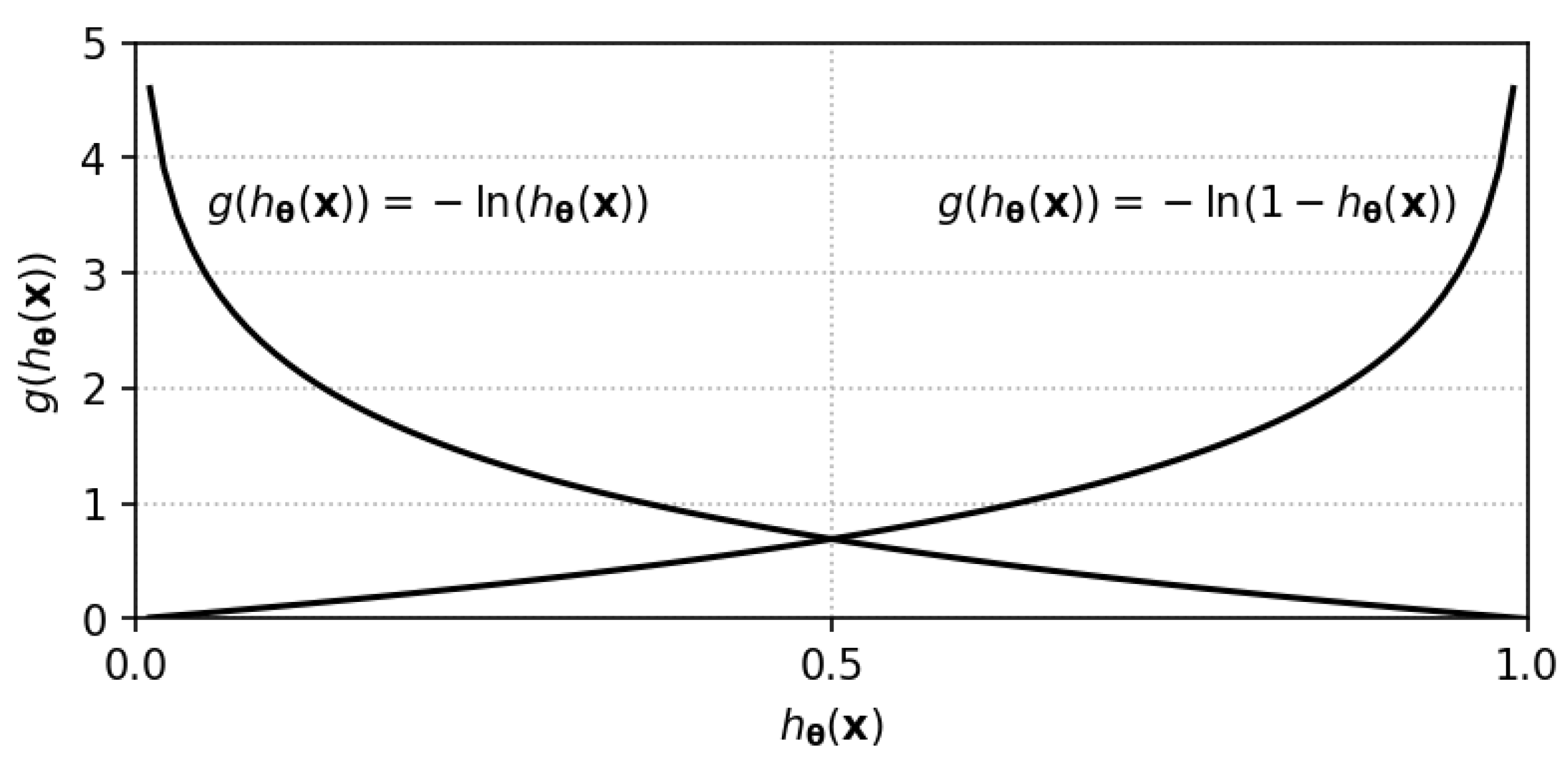
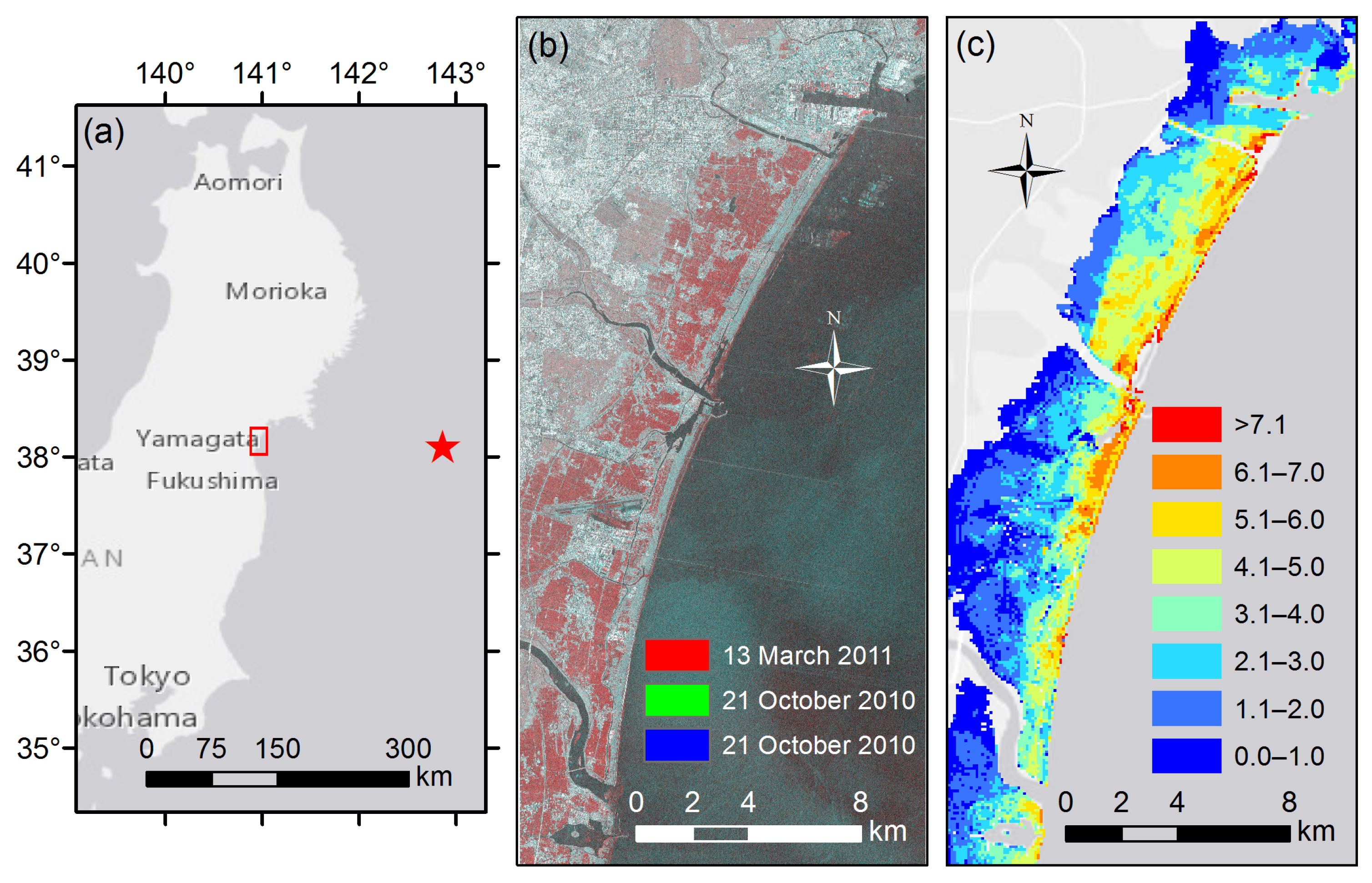
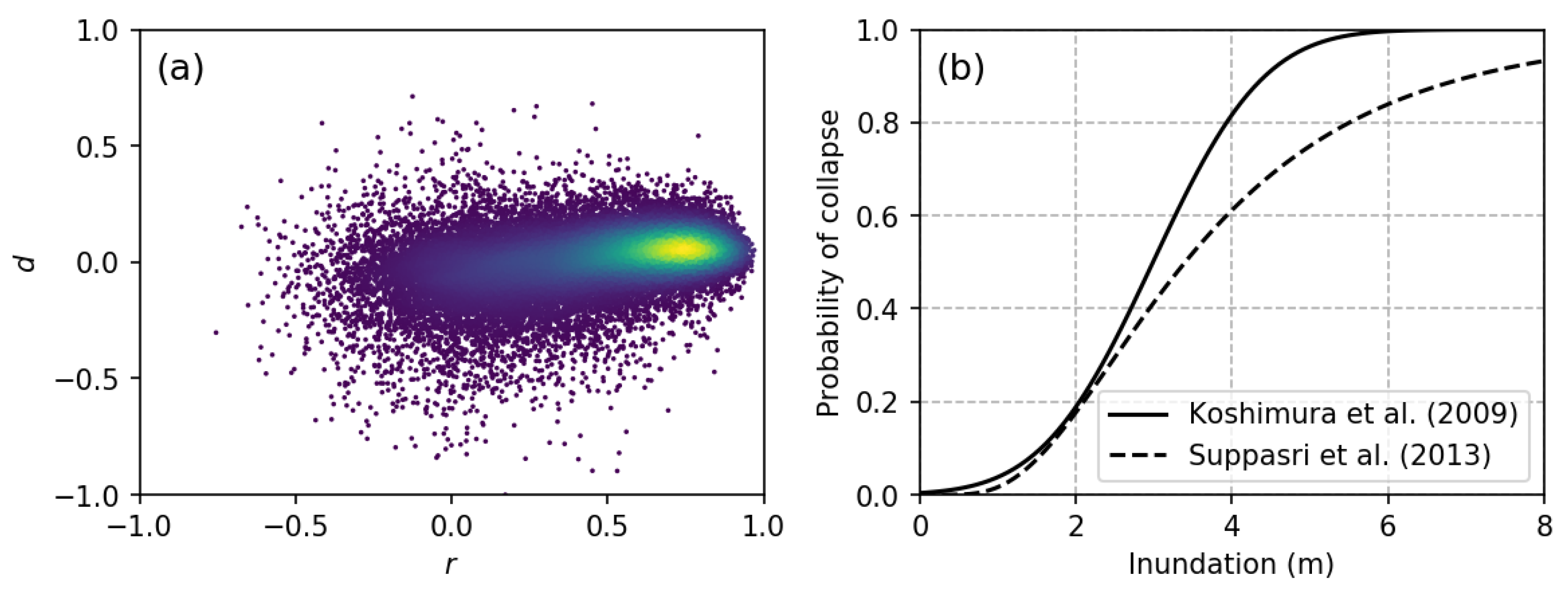
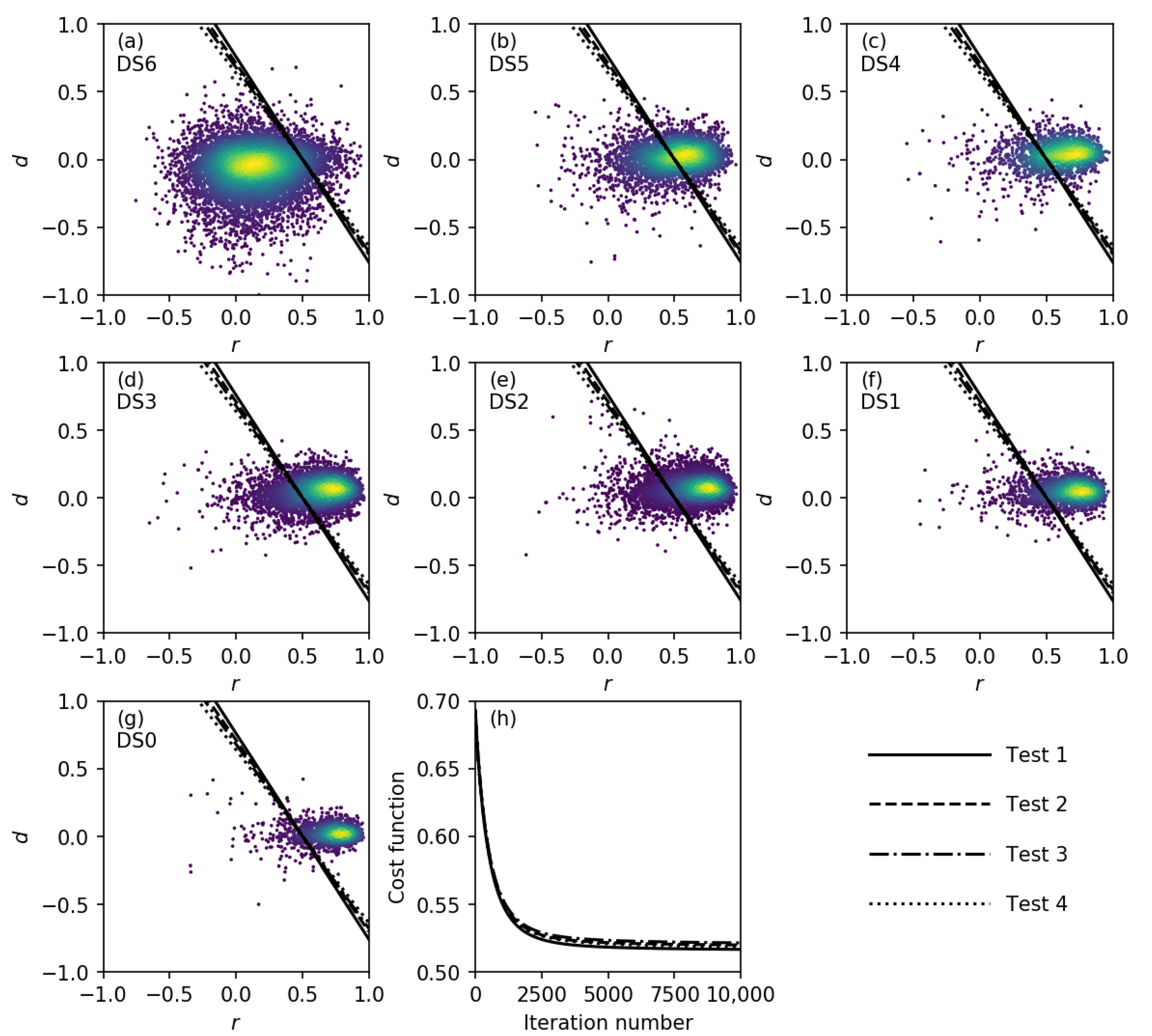

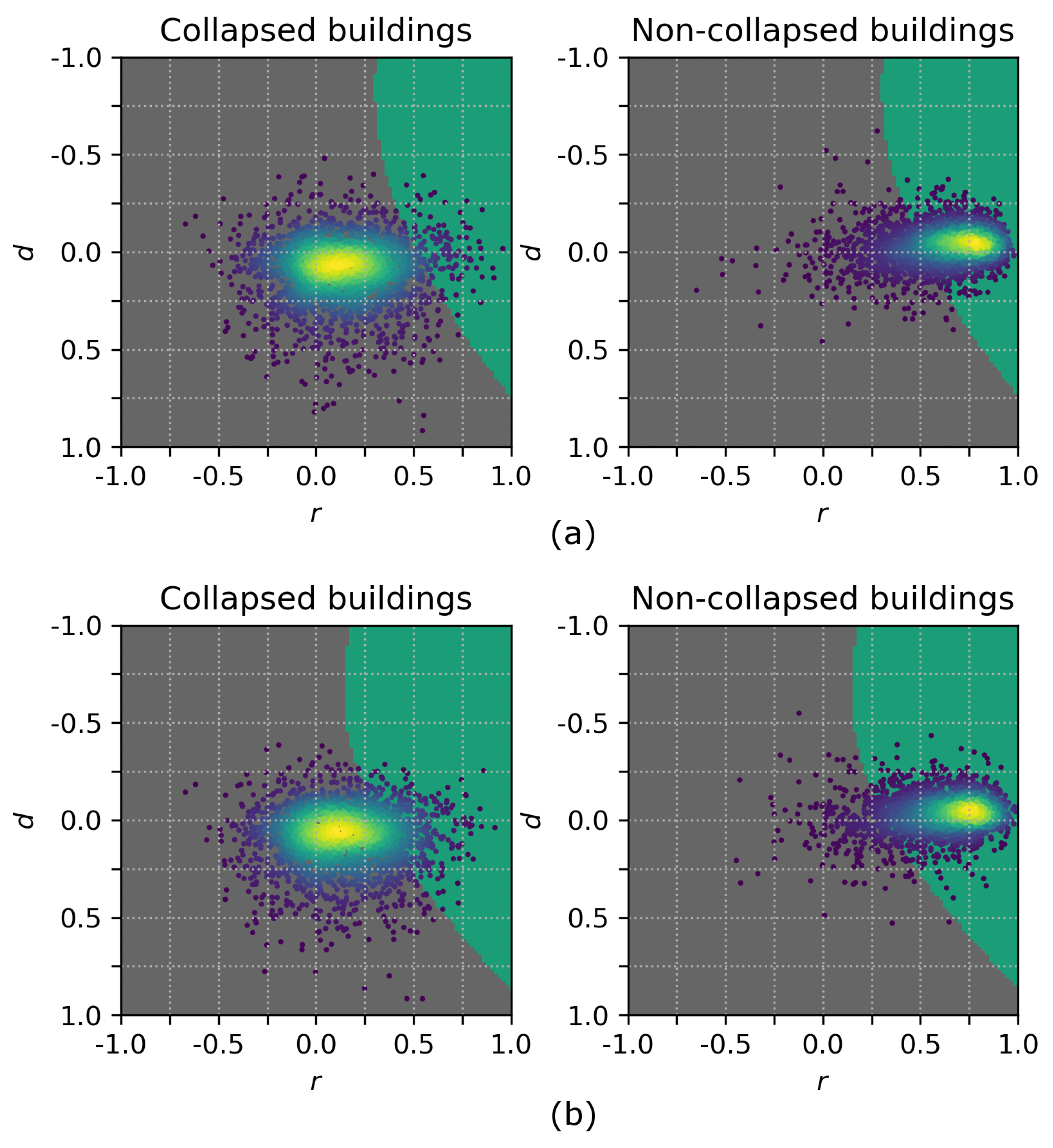
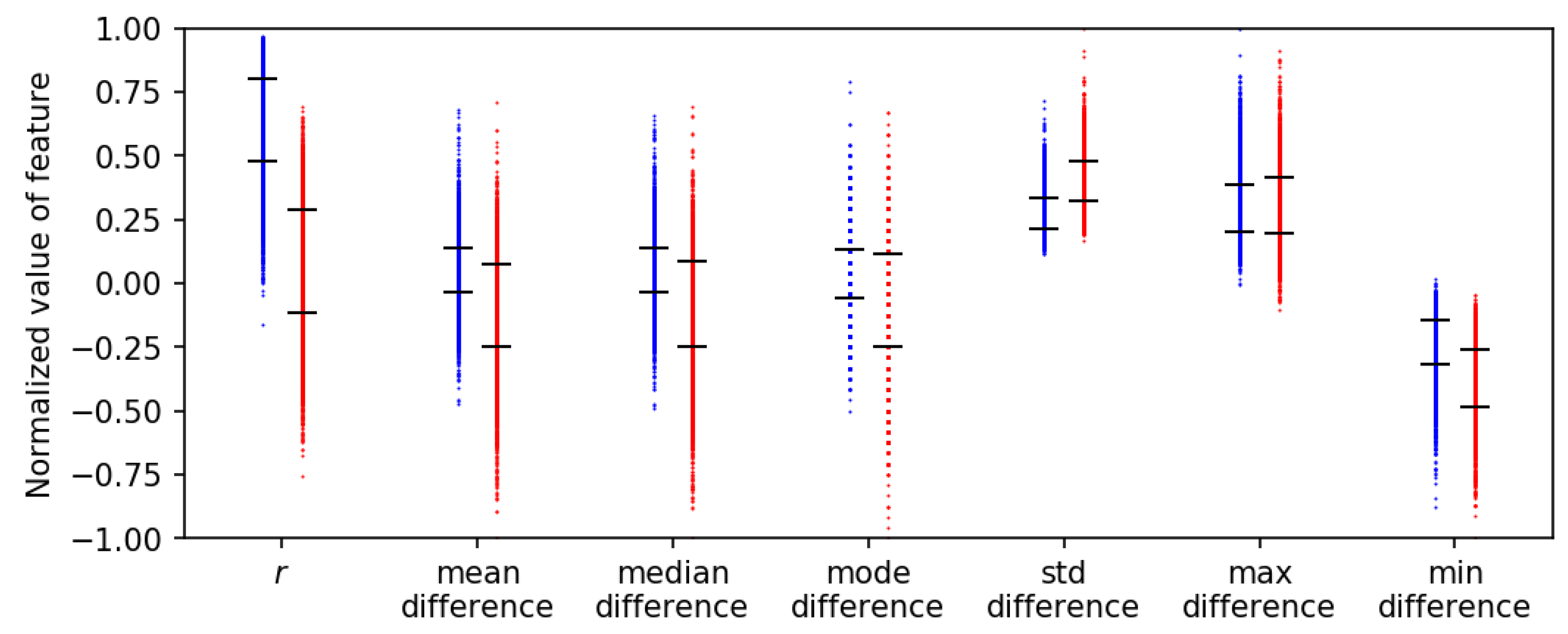
| DS0 | DS1 | DS2 | DS3 | DS4 | DS5 | DS0–DS5 | DS6 | Total | UA | |
|---|---|---|---|---|---|---|---|---|---|---|
| NC | 1668 | 2190 | 5655 | 4816 | 1179 | 2018 | 17,526 | 664 | 18,190 | 96.3 |
| C | 189 | 388 | 994 | 1204 | 516 | 1614 | 4905 | 8140 | 13,045 | 62.4 |
| Total | 1857 | 2578 | 6649 | 6020 | 1695 | 3632 | 22,431 | 8804 | 31,235 | |
| PA | 89.8 | 84.9 | 85.1 | 80.0 | 69.6 | 55.6 | 78.1 | 92.5 | 82.2 |
| DS0 | DS1 | DS2 | DS3 | DS4 | DS5 | DS0–DS5 | DS6 | Total | UA | |
|---|---|---|---|---|---|---|---|---|---|---|
| NC | 1793 | 2448 | 6264 | 5551 | 1475 | 2844 | 20,375 | 1861 | 22,236 | 91.6 |
| C | 64 | 130 | 385 | 469 | 220 | 788 | 2056 | 6943 | 8999 | 77.2 |
| Total | 1857 | 2578 | 6649 | 6020 | 1695 | 3632 | 22,431 | 8804 | 31,235 | |
| PA | 96.6 | 95.0 | 94.2 | 92.2 | 87.0 | 78.3 | 90.8 | 78.9 | 87.5 |
| DS0 | DS1 | DS2 | DS3 | DS4 | DS5 | DS0–DS5 | DS6 | Total | UA | |
|---|---|---|---|---|---|---|---|---|---|---|
| NC | 1649 | 2158 | 5534 | 4719 | 1153 | 1926 | 17,139 | 615 | 17,754 | 96.5 |
| C | 208 | 420 | 1115 | 1301 | 542 | 1706 | 5292 | 8189 | 13,481 | 60.7 |
| Total | 1857 | 2578 | 6649 | 6020 | 1695 | 3632 | 22,431 | 8804 | 31,235 | |
| PA | 88.8 | 83.7 | 83.2 | 78.4 | 68.0 | 53.0 | 76.4 | 93.0 | 81.1 |
| DS0 | DS1 | DS2 | DS3 | DS4 | DS5 | DS0–DS5 | DS6 | Total | UA | |
|---|---|---|---|---|---|---|---|---|---|---|
| NC | 1788 | 2419 | 6205 | 5492 | 1444 | 2738 | 20,086 | 1612 | 21,698 | 92.6 |
| C | 69 | 159 | 444 | 528 | 251 | 894 | 2345 | 7192 | 9537 | 75.4 |
| Total | 1857 | 2578 | 6649 | 6020 | 1695 | 3632 | 22,431 | 8804 | 31,235 | |
| PA | 96.3 | 93.8 | 93.3 | 91.2 | 85.2 | 75.4 | 89.5 | 81.7 | 87.3 |
| DS0 | DS1 | DS2 | DS3 | DS4 | DS5 | DS0–DS5 | DS6 | Total | UA | |
|---|---|---|---|---|---|---|---|---|---|---|
| NC | 1811 | 2484 | 6360 | 5634 | 1484 | 2882 | 20,655 | 2207 | 22,862 | 90.3 |
| C | 46 | 94 | 289 | 386 | 211 | 750 | 1776 | 6597 | 8373 | 78.8 |
| Total | 1857 | 2578 | 6649 | 6020 | 1695 | 3632 | 22,431 | 8804 | 31,235 | |
| PA | 97.5 | 96.4 | 95.7 | 93.6 | 87.6 | 79.4 | 92.1 | 74.9 | 87.2 |
| Class | Wieland et al. | IHF Method | |||||||
|---|---|---|---|---|---|---|---|---|---|
| Koshimura et al. | Suppasri et al. | ||||||||
| UA | PA | F1 | UA | PA | F1 | UA | PA | F1 | |
| C | 0.75 | 0.77 | 0.76 | 0.62 | 0.92 | 0.75 | 0.77 | 0.79 | 0.78 |
| NC | 0.76 | 0.74 | 0.75 | 0.96 | 0.78 | 0.86 | 0.92 | 0.91 | 0.91 |
| Total | 0.76 | 0.76 | 0.76 | 0.79 | 0.85 | 0.80 | 0.84 | 0.85 | 0.85 |
© 2018 by the authors. Licensee MDPI, Basel, Switzerland. This article is an open access article distributed under the terms and conditions of the Creative Commons Attribution (CC BY) license (http://creativecommons.org/licenses/by/4.0/).
Share and Cite
Moya, L.; Marval Perez, L.R.; Mas, E.; Adriano, B.; Koshimura, S.; Yamazaki, F. Novel Unsupervised Classification of Collapsed Buildings Using Satellite Imagery, Hazard Scenarios and Fragility Functions. Remote Sens. 2018, 10, 296. https://doi.org/10.3390/rs10020296
Moya L, Marval Perez LR, Mas E, Adriano B, Koshimura S, Yamazaki F. Novel Unsupervised Classification of Collapsed Buildings Using Satellite Imagery, Hazard Scenarios and Fragility Functions. Remote Sensing. 2018; 10(2):296. https://doi.org/10.3390/rs10020296
Chicago/Turabian StyleMoya, Luis, Luis R. Marval Perez, Erick Mas, Bruno Adriano, Shunichi Koshimura, and Fumio Yamazaki. 2018. "Novel Unsupervised Classification of Collapsed Buildings Using Satellite Imagery, Hazard Scenarios and Fragility Functions" Remote Sensing 10, no. 2: 296. https://doi.org/10.3390/rs10020296
APA StyleMoya, L., Marval Perez, L. R., Mas, E., Adriano, B., Koshimura, S., & Yamazaki, F. (2018). Novel Unsupervised Classification of Collapsed Buildings Using Satellite Imagery, Hazard Scenarios and Fragility Functions. Remote Sensing, 10(2), 296. https://doi.org/10.3390/rs10020296









